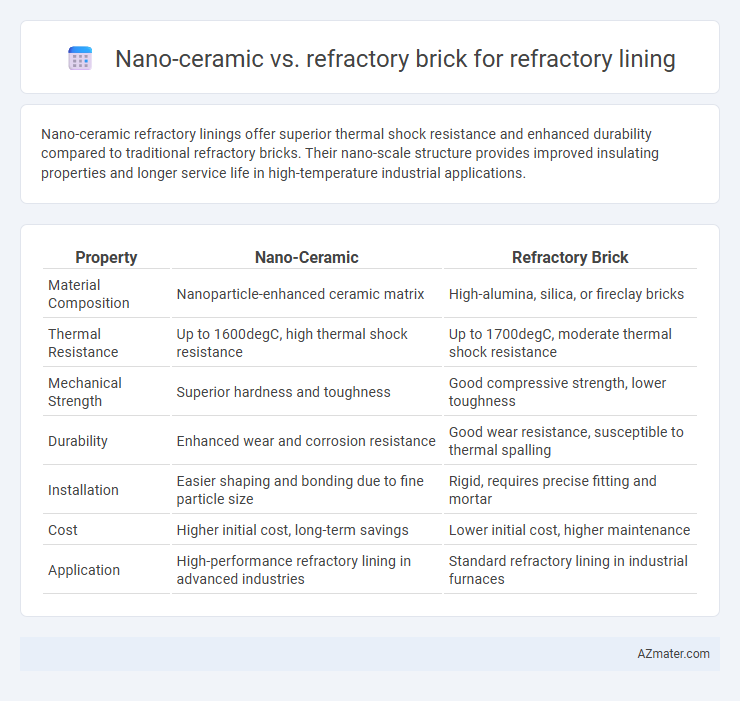Nano-ceramic refractory linings offer superior thermal shock resistance and enhanced durability compared to traditional refractory bricks. Their nano-scale structure provides improved insulating properties and longer service life in high-temperature industrial applications.
Table of Comparison
| Property | Nano-Ceramic | Refractory Brick |
|---|---|---|
| Material Composition | Nanoparticle-enhanced ceramic matrix | High-alumina, silica, or fireclay bricks |
| Thermal Resistance | Up to 1600degC, high thermal shock resistance | Up to 1700degC, moderate thermal shock resistance |
| Mechanical Strength | Superior hardness and toughness | Good compressive strength, lower toughness |
| Durability | Enhanced wear and corrosion resistance | Good wear resistance, susceptible to thermal spalling |
| Installation | Easier shaping and bonding due to fine particle size | Rigid, requires precise fitting and mortar |
| Cost | Higher initial cost, long-term savings | Lower initial cost, higher maintenance |
| Application | High-performance refractory lining in advanced industries | Standard refractory lining in industrial furnaces |
Introduction to Refractory Lining Technologies
Refractory lining technologies utilize materials such as nano-ceramic and refractory bricks to withstand extreme temperatures in industrial furnaces and reactors. Nano-ceramic linings offer enhanced thermal shock resistance and superior insulation due to their fine particle structure, improving energy efficiency and lifespan. Refractory bricks, traditionally composed of alumina, silica, and fireclay, provide robust mechanical strength and chemical stability, making them suitable for high-wear zones in high-temperature processes.
What is Nano-Ceramic Material?
Nano-ceramic material is composed of ultra-fine ceramic particles engineered at the nanometer scale, offering enhanced mechanical strength, thermal stability, and resistance to wear and corrosion compared to traditional refractory bricks. These materials exhibit superior thermal shock resistance and improved insulation properties, making them ideal for refractory linings in high-temperature industrial applications. The nano-scale structure ensures a denser and more uniform microstructure, resulting in longer service life and reduced maintenance costs for refractory linings.
Defining Traditional Refractory Brick
Traditional refractory bricks are composed primarily of alumina, silica, and fireclay, engineered to withstand high temperatures and thermal shock in industrial furnaces and kilns. These bricks provide excellent mechanical strength and resistance to chemical corrosion but often have lower thermal efficiency compared to nano-ceramic linings. Nano-ceramic materials enhance thermal insulation and durability by utilizing nanoscale particles that improve sintering and reduce porosity, offering a significant performance upgrade over conventional refractory bricks in harsh thermal environments.
Thermal Performance Comparison
Nano-ceramic refractory linings offer superior thermal insulation due to their ultra-fine particle structure, which minimizes heat conduction and enhances energy efficiency. Refractory bricks, while durable and widely used, generally exhibit higher thermal conductivity, leading to greater heat loss compared to nano-ceramics. The advanced thermal performance of nano-ceramic materials results in lower thermal expansion and improved resistance to thermal shock, making them optimal for high-temperature applications.
Durability and Lifespan Differences
Nano-ceramic refractory linings exhibit superior durability compared to traditional refractory bricks due to their enhanced thermal shock resistance and lower porosity, which significantly reduces wear and corrosion over time. The advanced nanostructure enables nano-ceramics to withstand higher temperatures and aggressive chemical environments, extending their effective lifespan well beyond the typical 3 to 5 years of conventional refractory bricks. This improved performance translates into reduced maintenance and replacement costs in industrial applications such as furnaces and kilns.
Installation and Maintenance Factors
Nano-ceramic linings offer faster installation due to their lightweight properties and ease of application compared to refractory bricks, which require skilled labor and longer curing times. Maintenance of nano-ceramic materials typically involves less downtime and reduced risk of cracking, whereas refractory bricks need regular inspection for joint integrity and potential spalling under thermal stress. The durability and thermal shock resistance of nano-ceramic components also contribute to lower long-term maintenance costs compared to traditional refractory brick linings.
Energy Efficiency and Heat Retention
Nano-ceramic refractory linings exhibit superior energy efficiency due to their low thermal conductivity and enhanced heat retention capabilities, significantly reducing heat loss in high-temperature applications. Compared to traditional refractory bricks, nano-ceramics provide a more uniform thermal barrier, allowing equipment to maintain optimal temperatures with less fuel consumption. Their advanced microstructure also contributes to faster heat-up times and prolonged heat retention, improving overall furnace performance and reducing operational costs.
Cost Analysis: Nano-Ceramic vs Refractory Brick
Nano-ceramic refractory linings typically incur higher initial costs due to advanced material properties and manufacturing complexity compared to traditional refractory bricks. However, nano-ceramics offer extended service life and improved thermal efficiency, potentially lowering overall lifecycle expenses in high-temperature industrial applications. Traditional refractory bricks, while more budget-friendly upfront, may require more frequent replacement and maintenance, increasing operational costs over time.
Industrial Applications and Suitability
Nano-ceramic refractory linings offer superior thermal shock resistance, enhanced chemical stability, and greater durability compared to traditional refractory bricks, making them highly suitable for high-temperature industrial applications such as steelmaking and petrochemical processing. Refractory bricks, while more cost-effective and easier to install, exhibit lower lifespan and performance under extreme thermal cycling and corrosive environments typical in glass manufacturing and cement kilns. Selecting nano-ceramic linings optimizes operational efficiency and longevity in industries demanding advanced heat containment and resistance to aggressive molten materials.
Future Trends in Refractory Lining Materials
Nano-ceramic refractory linings exhibit superior thermal stability, enhanced mechanical strength, and improved corrosion resistance compared to traditional refractory bricks, driving their adoption in high-temperature industrial applications. Advances in nanotechnology enable the customization of nano-ceramic composites for specific thermal environments, optimizing performance and lifespan of linings in furnaces and kilns. Future trends emphasize the development of eco-friendly, energy-efficient nano-ceramic materials that reduce maintenance downtime and emissions, positioning them as a sustainable alternative to conventional refractory bricks.

Infographic: Nano-ceramic vs Refractory brick for Refractory lining
 azmater.com
azmater.com